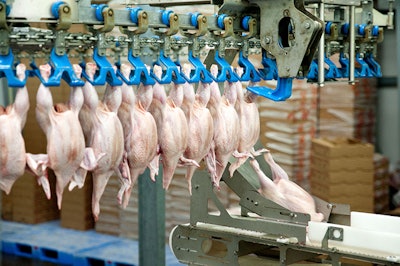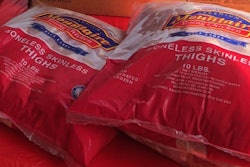
Poultry processors have become increasingly interested in robotics and automation to help reduce labor costs and improve efficiency in recent years.
“Our customers have changed their mindset about their ROI,” explained Michael Newcome, VP of Sales at JLS Automation, on December 3 during Food & Robotics: Protein Processing.
“What we’ve started to see is that they’ve changed their mind to start looking at the true costs of hiring, HR, ergonomics, employee retention and food safety. Food safety is hard to ignore now. Having automation interact with food versus a human provides a real food safety benefit.
The panel discussion on the future of robotic automation in protein processing also included Jonathan Keogh, Mechatronics Engineer at JBT FoodTech and Brandon Harrison, Applications Engineering Manager at Staubli.
Ready for sanitation
Poultry processing plants require strict sanitation procedures – something that needs to be carefully taken into account before any automated or robotic solution can be used.
“Because of the rigorous sanitation in processing facilities, hygienic design really needs to be considered at the beginning of the design phase. This comes into play with material selection, the design of the system and the design of the enclosure itself,” said Keogh.
Importance of end-of-arm tooling
All three presenters acknowledged the important role that the end-of-arm tooling plays for success, noting that the tooling will need to be unique depending on its application use and the type, temperature, texture and shape of the protein it is expected to handle.
“If I had to pick one thing that was most important to the success and performance of a robot, it would be the end-of-arm tooling design. It’s most definitely the most important make-or-break component of any machine,” Harrison said.
Machine vision will be critical
Machine vision – a form of artificial intelligence – will be critical to the success of robotics and automation in protein processing.
“In modern automation, it’s quite common to have some sort of vision system to check and find the location of a product or products for proper handling. Maybe it’s for a good part/bad part designation or to check sizing or coloration,” Harrison explained. “These products are critical for the food industry because the product can be variable in so many ways.”
A more user-friendly control interface
The user interface needs to be easy to use and understand before widespread adoption of robotics in protein processing can occur.
“This is an area that we think is incredibly important for adoption. We put a lot of these systems into environments where there’s not a high level of technical knowledge. So the mindset has been to make the interface as easy and visual as possible,” said Newcome.
Like what you just read? Sign up now for free to receive the Poultry Future Newsletter.


















